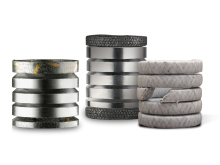Valve Stem Packing
Valve Stem Packing From a Leading UK Manufacturer
For more than 50 years, M Barnwell Services has provided Valve Stem Packing to companies worldwide. As one of the UK’s biggest independent fluid seal stockists and distributors, our customers can trust that they will receive the right product for their needs.
Our proficient team manages the entire production process, from prototyping and testing to final part manufacturing. Additionally, we offer specialised certification upon request.
If you would like more information about our range, or contact a team member.
Valve stem packing serves as a crucial sealing element within control valves. It surrounds the valve stem, preventing leaks and ensuring a tight seal between the stem and the valve body. If you observe any leaks around the valve stem, it’s likely due to a problem with the packing.
Swift detection and resolution of such leaks are vital to prevent further complications and maintain the valve’s proper functioning.
Types of Valve Stem Packing
Valve packing is available in rope or ring shapes, commonly made from materials like Graphite or Teflon™.
Teflon™ is typically the prevalent choice for pre-shaped ring packing material due to its self-lubricating properties. A spring beneath the gland follower commonly secures these Teflon™ rings.
Hydraulic and Pneumatic systems extensively utilise another variation of this packing style, known as “Chevron” packing.
The rope form allows customisation by cutting it to the needed size, making it adaptable for various valve stems. Due to its versatility and customisation potential for specific valve stem requirements, industries like Oil and Gas widely employ this type of packing.
Valve Stem Packing can be made from a variety of materials.
When is Valve Stem Packing Needed?
Valve stem packing leaks can pose risks to both oilfield personnel and the environment. It’s crucial to promptly identify and address any packing leaks to prevent escalating damage. To resolve this, you can address the issue by cautiously tightening the valve packing nuts to reseal the leak. However, be cautious not to overtighten the nuts, as this could potentially exacerbate the problem.
Valve packing is crucial for creating effective seals around stems or spindles in specific valve types. These valves include:
- Globe Valves: Seal around the stem to prevent leakage when closed.
- Gate Valves: Seal to prevent leakage when the valve is shut.
- Ball Valves: Used in larger or high-pressure valves as an additional stem seal.
- Plug Valves: Seal around the plug or core to prevent leakage.
- Diaphragm Valves: Certain designs may use valve packing alongside a diaphragm.
- Butterfly Valves: Some large/high-pressure models may use packing for added stem sealing.
Note that not all valves require packing; some rely on different sealing methods based on their design.
Valve Stem Packing Materials
- Graphite Packing: Crafted from flexible graphite, it boasts high-temperature and chemical resistance, making it suitable for applications involving steam, chemicals, and high-temperature fluids.
- Flexible Graphite Ribbon Packing: These ribbons offer versatility and effective sealing for valve stems, often in cases of irregular or larger valve stems.
- PTFE (Teflon™) Packing: PTFE (Polytetrafluoroethylene) packing gains renown for its remarkable chemical resistance and low friction properties. It serves well across various applications, including those with corrosive chemicals.
- Expanded PTFE (Teflon™) Packing: Made from expanded PTFE, this packing provides top-notch sealing capabilities and chemical resistance. It’s utilised in applications requiring a high level of chemical compatibility.
- Aramid Fiber Packing: Comprising aramid fibers, this packing offers strength and durability. It’s favored in situations necessitating resistance to abrasion and wear.
- Carbon Fiber Packing: Carbon fiber packing offers high-temperature resistance and is suitable for applications involving high-speed rotating equipment and aggressive chemicals.
- Synthetic Fiber Packing: These packings are constructed from synthetic fibers, balancing cost-effectiveness with performance. They are versatile and fit various general-purpose applications.
- Ceramic Fiber Packing: Engineered for high-temperature environments, ceramic fiber packing excels in thermal insulation properties. It’s employed in processes dealing with extreme heat.
- Metallic Packing: Crafted from metal wires, metallic packings exhibit strength and resistance to high pressures. They thrive in sealing under extreme conditions.
- Die-Formed Packing Rings: Precision-formed from diverse materials, these rings effectively seal valve stems. They offer reliable performance and come in different cross-sectional shapes.
- Rubber Padding Packing: Utilised in forms like rubber cloth, rubber packing ring, or rubber rod, this type of packing suits applications with temperatures below 140°C.
Factors to Consider When Selecting Materials
- Nature of the fluid or gas in use.
- Applicable temperature range.
- Pressure range.
- Leakage tolerance.
- Wear and friction characteristics of sealing materials.
- Operational and maintenance expenses.
- Surrounding environmental factors.
Applicable Industries
- Oil and Gas
- Chemical Processing
- Petrochemical
- Power Generation
- Water Treatment
- Pharmaceutical
- Food and Beverage
- Pulp and Paper
- HVAC (Heating, Ventilation, and Air Conditioning)
- Marine
You Are In Safe Hands
As a reliable partner to global OEM manufacturers, M Barnwell Services ensures quality products and an exceptional service experience. With £5.1 million in sealing inventory and five UK branches strategically positioned, we’re primed to meet and surpass your needs.
For further details about our offerings, access our catalogue, explore the Compression Packing Page, or contact a member of the team.



